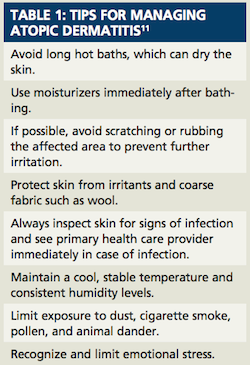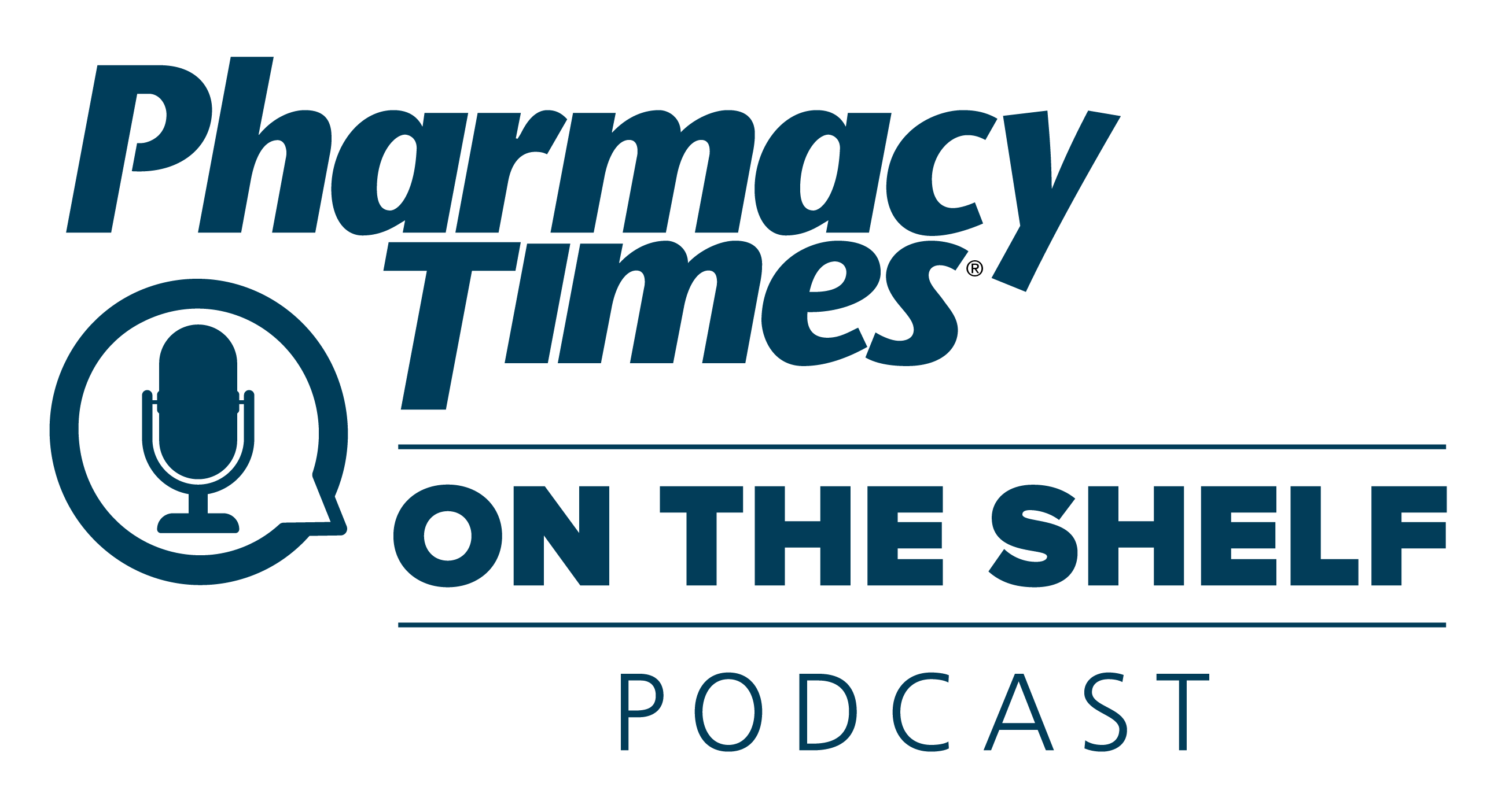Publication
Article
Pharmacy Times
Treatment and Management of Dermatitis
Author(s):
Topical non-prescription products can provide relief from dermatitis.
Topical non-prescription products can provide relief from dermatitis.
A number of topical non-prescription products are available to provide symptomatic relief and aid in managing atopic dermatitis and contact dermatitis. Atopic dermatitis, often referred to as “eczema,” is a general term for several types of inflammation of the skin.1 It is characterized by erythematous, scaly, and itchy rashes, and is the most common type of eczema.1
The prevalence of atopic dermatitis is approximately 10% to 12% in children and 0.9% in adults.2 Atopic dermatitis is thought to be an immune-mediated inflammation of the skin caused by genetic and environmental factors.1-4 Common factors that may precipitate or exacerbate atopic dermatitis include food allergies, airborne allergens (eg, dust mites, mold), exposure to fragrances or chemicals, changes in temperature, cold or dry air in the winter, and emotional stress.1-4 Individuals with atopic dermatitis often have asthma or seasonal allergies as well.1-6
Contact dermatitis (CD) is characterized by acute inflammation of the skin as a result of exposure to irritants or allergens.4,7 Symptoms of contact dermatitis and their severity vary from patient to patient and are dependent upon the allergen or irritant and extent of exposure to it.7-10 Patients with contact dermatitis may have inflamed and swollen skin and may present with symptoms such as pruritus, erythema, and formation of vesicles and pustules.7-10
The 2 types of contact dermatitis are irritant contact dermatitis (ICD) and allergic contact dermatitis (ACD).7-10 ICD, which accounts for approximately 80% to 90% of cases, is an inflammatory reaction of the skin typically resembling a burn that is caused by exposure to an irritant such as a chemical or household cleaning product.7-10 CD is commonly related to one’s occupation and tends to occur as a result of frequent and repeated use of hand hygiene products, exposure to chemicals, or glove use.7-10 Most ICD cases occur on exposed or unprotected areas of the skin, such as the face, hands, and arms.7-10 Approximately 80% of ICD cases occur on the hands and another 10% involve areas of the face.7-10 The most common symptoms include inflammation, edema, erythema, and crusting and formation of pustules or vesicles.7-10

ACD, the second-leading cause of CD cases, is an inflammatory skin reaction caused by exposure to an allergen, such as poison ivy, oak, or sumac.7-10 Metal allergies, especially to nickel salts found in jewelry, clothing, and cell phones, are another common cause of ACD.7-10 Cosmetics, fragrances, and some skin care products can also cause ACD.7-10 Signs and symptoms of ACD may include swollen, red skin and localized pruritus, rash, pain, and formation of blisters.7-10 In general, ACD is confined to the contact area, while ICD may appear more wide-spread on the skin.7-10 A red rash typically appears immediately in cases of ICD, while in ACD, a rash may not appear for 24 to 48 hours after exposure to an allergen.7-10
Nonprescription Topical Products
OTC products marketed for dermatitis may contain a combination of ingredients in various dosage forms, such as creams, ointments, gels, lotions, and sprays. Hydrocortisone is considered the most effective topical therapy for mild to moderate cases of dermatitis that do not involve edema or extensive areas of the skin, as well as in cases of atopic dermatitis.4,5,8 Hydrocortisone is available without a prescription in 0.5% or 1% strengths. It should not be used in those younger than 2 years and should generally not be used for longer than 7 days unless directed by a physician.4,5,8 Hydrocortisone should not be applied to broken or cracked skin.8
The new Neosporin Eczema Essentials (Johnson & Johnson) products for those with eczema include a daily moisturizing cream, daily body wash, and anti-itch cream. These products contain a special formulation of ingredients that help retain moisture for healthy skin. There is also a range of topical products marketed for eczema, such as medicated washes, lotions, and creams.
For the relief of itching, patients with CD may elect to use topical antihistamine products. However, topical antihistamine use is not advised in those with atopic dermatitis.4,8 Patients should be reminded that topical antihistamines may cause sensitivity reactions and should not be applied to large areas of the skin or used concurrently with other products containing antihistamines, including oral dosage forms.8 It is also important to remind patients that topical antihistamines should not be applied to broken, blistered, or oozing skin and should not be used for longer than 7 days unless otherwise directed.8 External analgesics, such as phenol, menthol, and camphor, are also available in various dermatological products and may provide anti-pruritic and anesthetic relief.8 In order to avoid local irritation and burning, these products should not be used on open lesions or inflamed skin.8
If appropriate, patients with CD may also use astringent products (ie, aluminum acetate, zinc oxide, zinc acetate, etc) to promote drying of moist, wet, oozing lesions as well as to provide a protective covering for inflamed skin.8 Calamine and colloidal oatmeal baths can also help provide relief from itching.8
Before recommending any product for dermatitis, pharmacists should determine whether self-treatment is appropriate and refer patients to seek further medical evaluation when warranted, especially if signs of skin infection are present. Patients under the age of 2 years should always be referred to their primary health care provider for appropriate treatment. To avoid allergic reactions, patients with allergies to skin care products and cosmetics should be advised to use hypoallergenic products.
During counseling, patients should be instructed on the proper use of the selected product, as well as possible adverse effects. Patients should be reminded to immediately contact their primary health care provider if there are no signs of improvement after self-treatment, if there are signs of infection, or if symptoms worsen. Patients with atopic dermatitis should be advised to seek medical care if skin does not improve or worsens after 2 to 3 days of therapy. Typically, both ICD and ACD will resolve in 10 to 21 days with or without medical treatment.8
Ms. Terrie is a clinical pharmacy writer based in Haymarket, Virginia.
References:
- Atopic dermatitis. National Institute of Arthritis and Musculoskeletal and Skin Diseases website. www.niams.nih.gov/health_info/Atopic_Dermatitis/default.asp#a. Accessed March 8, 2013.
- Kim B. Atopic dermatitis. Medscape website. http://emedicine.medscape.com/article/1049085-overview#a0156. Accessed March 8, 2013.
- Atopic dermatitis. Merck Manual for Healthcare Professionals Online Edition. www.merckmanuals.com/professional/dermatologic_disorders/dermatitis/atopic_dermatitis.html?qt=atopic dermatitis&alt=sh. Accessed March 8, 2013.
- Beers M, et al. Dermatological disorders. The Merck Manual of Diagnosis and Therapy. 18th ed. Section 10:957-1058.
- Scott S. Atopic dermatitis. In: Krinsky D, Berardi R, Ferreri S, et al, eds. Handbook of Nonprescription Drugs. 17th ed. Washington, DC: American Pharmacists Association; 2012.
- Atopic dermatitis. US National Library of Medicine website. www.ncbi.nlm.nih.gov/pubmedhealth/PMH0001856/. Accessed March 8, 2013.
- Contact dermatitis and latex allergy. Centers for Disease Control website. www.cdc.gov/oralhealth/infectioncontrol/faq/latex.htm. Accessed March 8, 2013.
- Plake K, Darbishire P. Contact dermatitis. In: Berardi R, Newton G, McDermott JH, et al, eds. Handbook of Nonprescription Drugs 16th ed. Washington, DC: American Pharmacists Association; 2009:657-672.
- Contact dermatitis. Medline Plus website. www.nlm.nih.gov/medlineplus/ency/article/000869.htm. Accessed March 7, 2013.
- Contact dermatitis. MedicineNet website. www.emedicinehealth.com/contact_dermatitis/page3_em.htm. Accessed March 8, 2013.
- Dermatitis. Cleveland Clinic Health Information website. http://my.clevelandclinic.org/disorders/dermatitis-atopic_eczema/hic_dermatitis.aspx. Accessed March 9, 2013.







